All about grafting apple trees in the fall
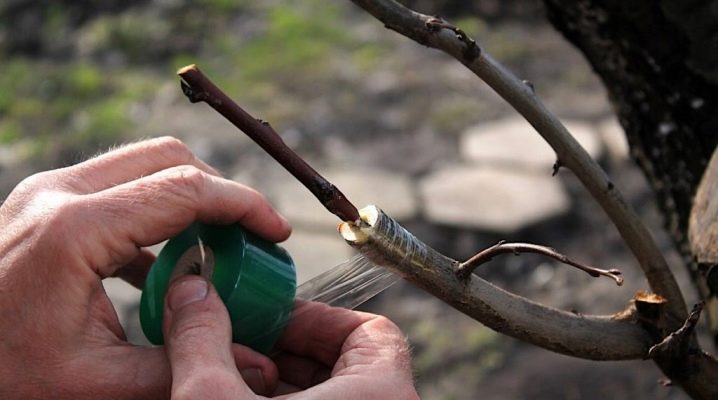
If apple trees grow in your summer cottage, you should provide them with proper and thorough care. Vaccinations are important here. They can be held at different times. Today we will talk about how to properly do such a procedure in the autumn season.

Peculiarities
Grafting is an event in which several parts of a plant are connected and fixed. This allows, among other things, to obtain completely new varieties of vegetation.
It is believed that such a procedure is best carried out in the spring, because during this period the process of sap flow is started in apple trees., while new cuttings have time to get strong enough before the onset of frost. If you did not manage to get vaccinated at this time, then it can be postponed to the autumn season.
But it is worth remembering that autumn grafting is considered more difficult than spring and summer grafting. It is carried out in a short time, otherwise the grafts may simply not take root.
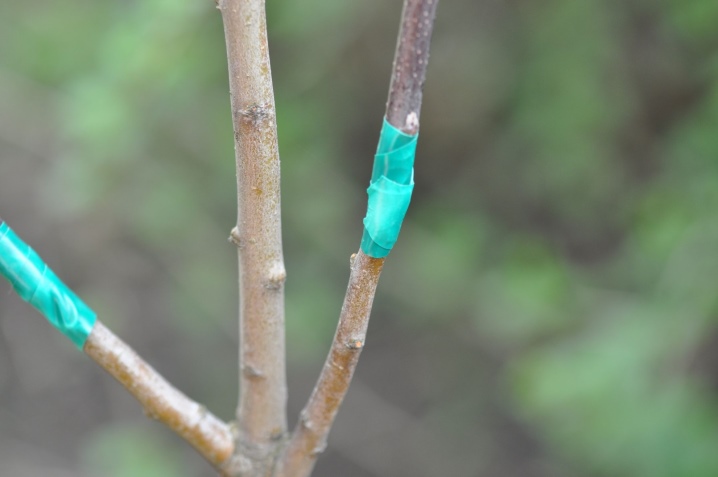
Grafting an apple tree in the fall is an effective way to significantly increase fruiting. And also it can help rejuvenate vegetation, improve the taste of ripe fruits. Young seedlings that were grafted in the fall tolerate transplants much easier and take root more easily in a new area.
It should be noted that grafting these garden trees is optional, but it also saves vegetation from damagecaused by rodents and severe frosts, as new healthy shoots will begin to appear on the affected areas.
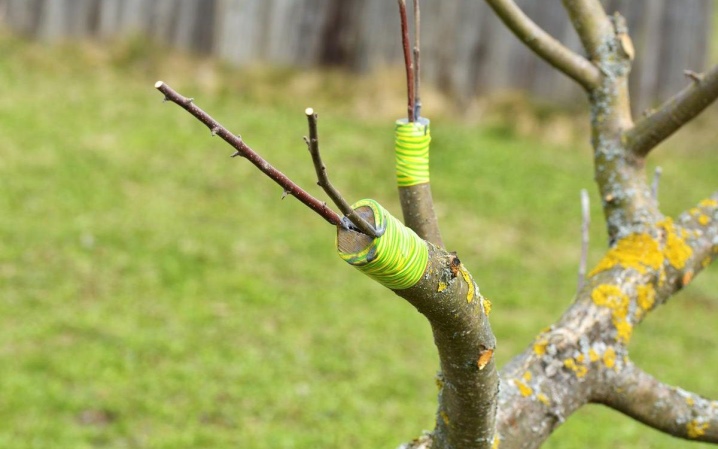
Besides, this procedure allows you to save space on your land. Indeed, in small areas, there is often not enough space for planting a large number of fruit trees. To get more varieties, branches from several different apple trees can be easily grafted onto one plant. It is worth remembering that periodic vaccinations always allow you to get a full harvest, a developed and strong base and healthy fruit-bearing branches.
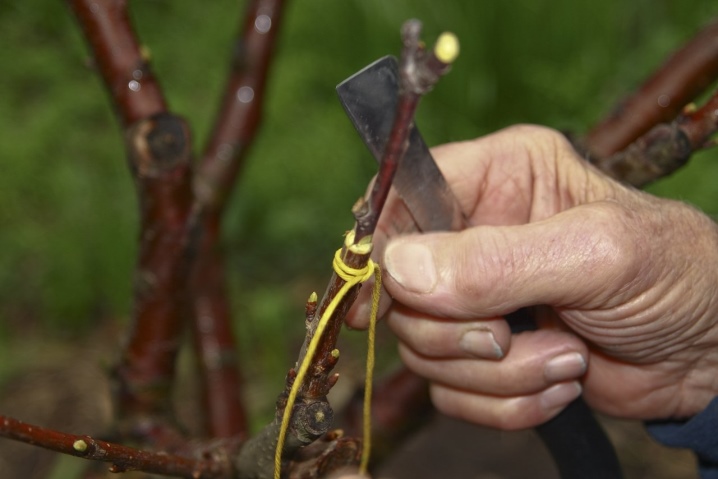
Timing
In advance, you should decide on the exact timing of the vaccination of apple trees. In this case, much will depend on the region in which such plants are grown. So, in the Urals and Siberia, they are most often carried out in the month of September.
For the middle lane, the Moscow region, the end of September will be the best option. In the south, the procedure can be carried out in October. Sometimes grafting is done there in late autumn.
And also carrying out such an event in a later period can be carried out in greenhouses or at home, while only young seedlings are used.
Besides, grafting of an old tree is best done in the first half of September. The procedure with a young tree can be carried out at the end of September, in October.
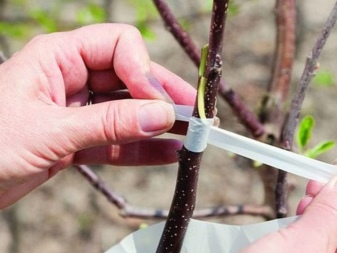
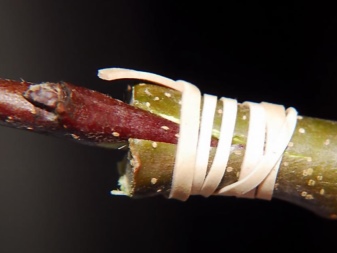
Tools and materials
Before proceeding with the procedure itself, you will need to prepare everything you need for this.
-
Pruner. It comes in handy for cutting branches quickly and easily.
-
Garden knife. It is used for cutting off thick branches, as well as in order to give all the cuts the desired shape. Sometimes a saw is used for these purposes.
-
Garden tape. With the help of such material, the resulting slices are rewound.
-
Garden var. It is used to cover the sections. Sometimes a simple whitewash or other disinfectants are taken for this.
-
Screwdriver. It will allow you to make splits in the thick branches.
-
Oculus knife. This garden tool has a rounded blade with a sharp tip for peeling bark.

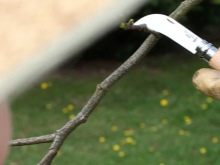

It is also recommended to prepare gloves, all work is best done in them. Disinfectants may also be needed to treat instruments. It is better to process sections with such substances. After all, harmful bacteria and infection can easily enter them.
All tool blades must be well sharpened. Otherwise, the cuts will not turn out even and smooth.
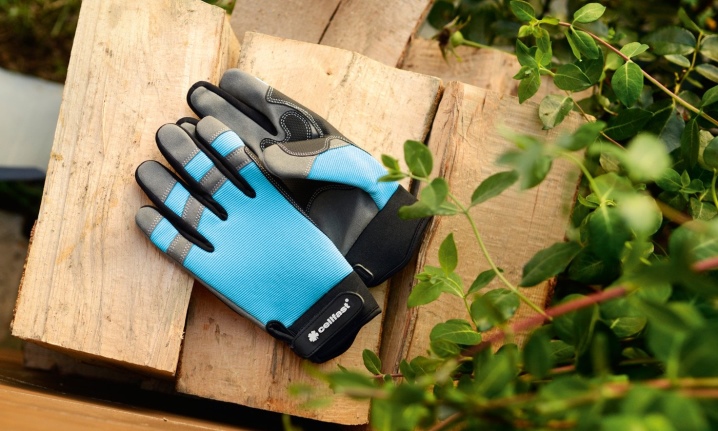
Stock preparation
Before starting grafting, you should prepare the stock. At the same time, it is recommended to choose only the strongest and strongest plants. It is important that there are no build-ups, deformed areas, seals on them. And also make sure that all leaf blades are of their natural color.
There should be no signs of disease or pests on the trees. Look carefully at their bark. There can be no cracks or other similar defects on it.
The best option would be seedlings from an apple tree, which is only 2-3 years old. It is believed that they are the easiest to adapt to new conditions. If desired, the stock can be grown independently. To do this, you will need to prepare seed material and plant it in open prepared soil.

Basic ways
There are several different methods of grafting apple trees. Let's take a closer look at each of them.
Budding
In this case, we are talking about a kidney vaccination. In the autumn, a sleeping eye is used. It must be elastic, without deformation or other damage. Budding is carried out from mid-August to early September.
To begin with, the bud of the scion should be grafted in place of the bud on the rootstock. Moreover, the area you have chosen should be immediately wiped with a damp cloth material to remove all dust and debris. After that, a small incision is formed on the bark of the stock, it should have a T-shape. The vertical section will be about 3 cm long and the horizontal section will be about 1.5 cm long.
Then you will need to cut off the bud from the one-year-old branch. In this case, the width of the scion will be 1.5 cm, and the length - 3 cm. When carrying out this action, the knife should be held almost parallel to the kidney.
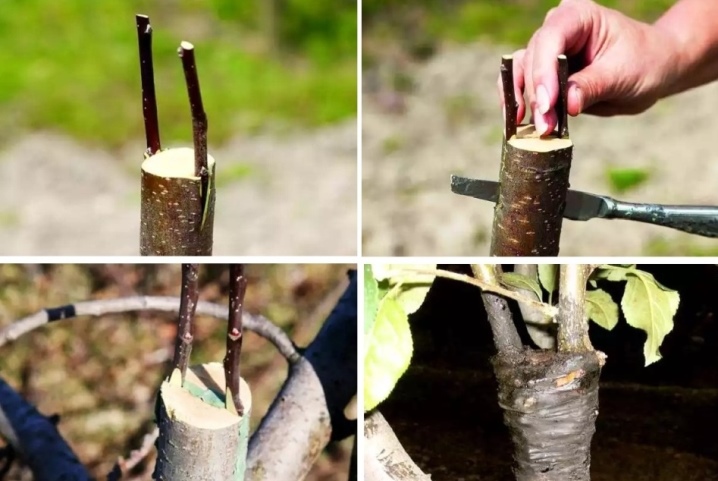
The bark leaves on the rootstock are then gently pushed apart. A graft bud is inserted into this place. Next, the flaps should be closed, the peephole should be located in the central part and protrude slightly outward.
At the final stage, the place where the connection took place must be tightly wrapped with a special garden tape or film. The peephole must not be touched.

Into the cleft
This method is considered the simplest, even a beginner can handle it. First, the scion must be cut at a 90 degree angle. Both a branch and a trunk can act as it. In the latter case, grafting is carried out no lower than at a height of about 15 centimeters from the surface of the earth.
After that, the cut must be protected from dust and other debris. A split is formed along the central part.
If the scion is thin, then its depth should be no more than 3 of its diameters. If the scion is rather thick, then it can be 6-8 diameters. To prevent the split from closing, the stock should be carefully inserted into it. The place where the connection took place is tightly wrapped with electrical tape or special garden tape. All open cut areas are carefully coated with garden varnish or whitewash.
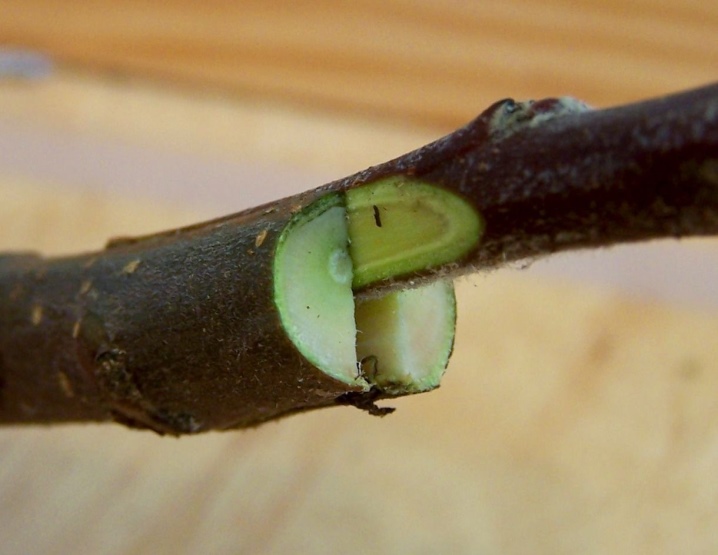
Copulation
This method should only be used when the rootstock and scion have the same diameter. The method involves connecting the cuts of the branches and the most dense winding. Copulation is quite simple to perform, but it should be remembered that it does not always provide proper survival.
First, you will need to make an oblique and even cut, the length of which should be about 3-4 centimeters. In order for this part to be smooth, it is recommended to work with a sharp garden tool and move towards you.
Then the lower end of the scion must be cut diagonally. It must match the stock. There will be 3-4 buds on the scion, and its length will be from 10 centimeters.
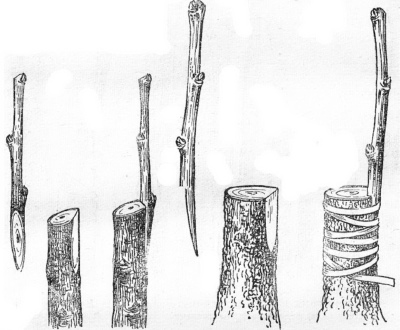
The cut of the scion is applied to the cut of the stock with light rubbing movements, so that in the end the layers coincide with each other. Make sure that there are no free areas.
Further, the joints are tightly wrapped with tape or electrical tape. All open parts are treated with garden varnish or whitewash.
Sometimes the method of improved copulation is also used, which can significantly increase the chances of survival. In this case, the same oblique cuts are formed on the rootstock and scion, their length should be 3-4 centimeters. It is important not to touch the trimmed areas with your hands.

Then, from the bottom of the cut rootstock, you need to retreat about 1/3 of the length.
There they make a small notch with a depth of no more than one centimeter. After that, approximately 1/3 of the length is also measured on the scion and a notch is also made.
Next, the stock and the scion are carefully connected, while inserting the parts obtained in the places of the notches into each other. At the final stage, tight winding and processing with pitch or lime are carried out.
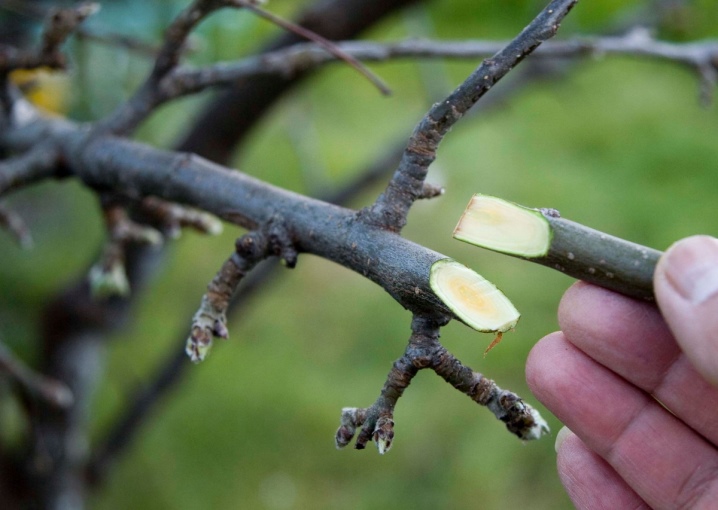
For the bark
With this method, apple branches are grafted behind the bark when they are grown on the stump of an old plant. Sometimes a saw cut is used instead of hemp. As a rule, several rootstocks are taken for one scion.
If the cuttings are grafted onto a stump, then it is cut down at a height of 70-100 centimeters from the surface of the earth. Moreover, it will be necessary to leave 3-4 skeletal branches in order to provide the vegetation with juice.
The place of the saw cut is carefully sanded, and also cleaned of debris. Further, at the edges of the cut of the scion, longitudinal cuts 5 centimeters long are formed downward, all this is carried out along the bark of the tree.
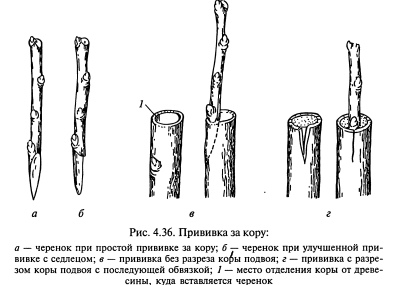
The number of such cuts should be equal to the number of cuttings.
The graft is carefully cut at an angle. The length of the cut obtained should be equal to 4 diameters of the cutting. The leaves of the bark of the wood open a little. The scion must be inserted into the resulting "window". This is done in such a way that the cut is as tightly and evenly adhered to the rootstock wood and is located about 2-3 millimeters above the border of the rootstock cut.
The wood flaps are closed back. A tight winding is carried out at all joints. At the final stage of grafting, the open parts are thoroughly coated with garden varnish.
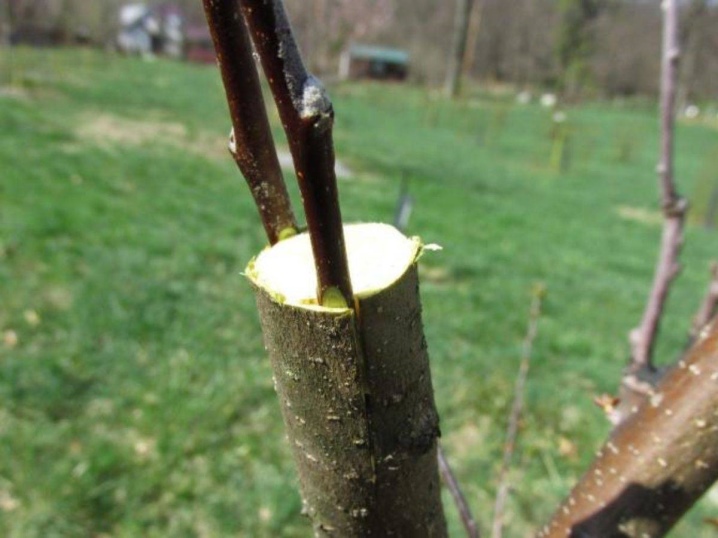
Follow-up care
If you have carried out the procedure for grafting an apple tree, you should know about some important rules of subsequent care. So, do not forget that it will be necessary a couple of weeks after this procedure to check whether the scion was able to take root, and whether the wound healed. If this does not happen, then the wound is once again well lubricated with garden varnish, and in this form everything is left until the onset of the spring season.
And it is also necessary to remove all shoots that will form below the vaccination site. If this is not done, then they can draw out all the juices. All fresh vaccinations should be protected from sunlight. In hot weather, it is better to shade them.
A week after the procedure, the fruit tree must be abundantly moistened with water at room temperature. It is better to apply fertilizers to the area of the trunk circle, humus and manure will be able to come up. All this is well mulched.
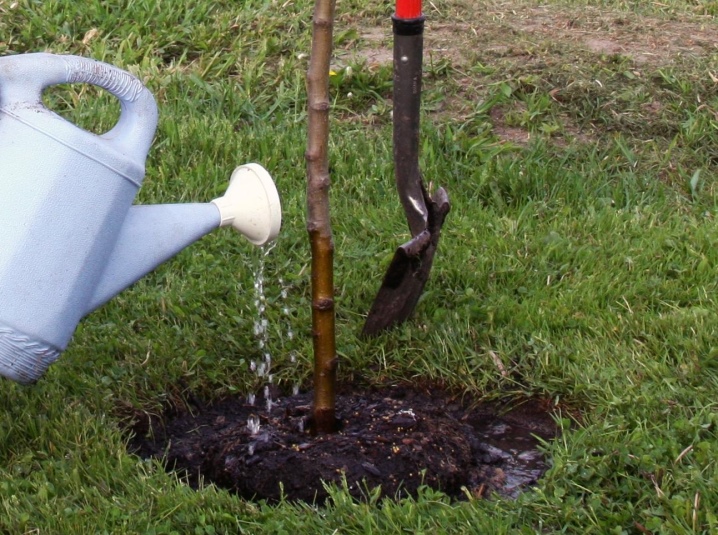
If you notice that the stalk has taken root, and shoots have appeared on it, then you need to choose and leave the strongest and strongest of them, all other parts are cut off. It is recommended to leave these elements at the top of the branch.
When the vaccinations have grown enough, they will need to be tied to a support for the first three years., because during this period the joints of plant tissues will still not be sufficiently reliable and strong.
Before the onset of the winter season, the plants must be insulated.To do this, they are tied with a dense cloth or special insulation. At the same time, the area of the trunk circle is well mulched.
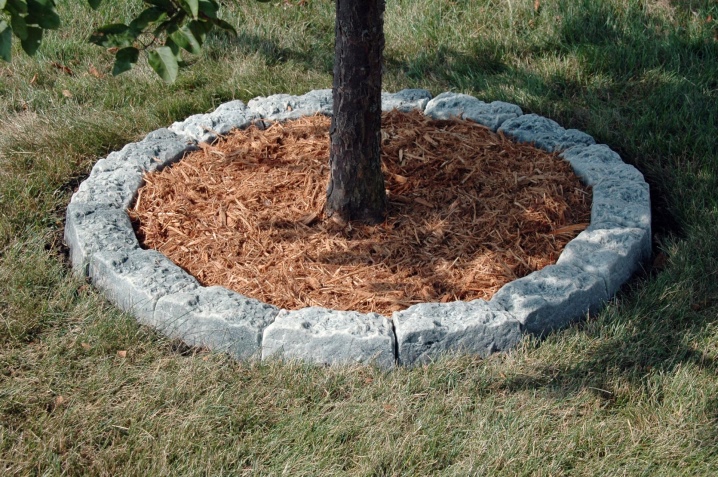
Useful Tips
When grafting such fruit trees, it is worth remembering some important recommendations. During the procedure, do not touch the cut sites with your hands. Work is best done only with gloves. In this case, it is also better to pre-treat the instruments with a disinfectant.
If you decide to use electrical tape for winding, then remember that it is wound with the adhesive side out. Otherwise, when removing it, the fusion points may be severely damaged.
If you don't have a garden varnish, use lime. The winding during the autumn vaccination will need to be removed in the spring season.
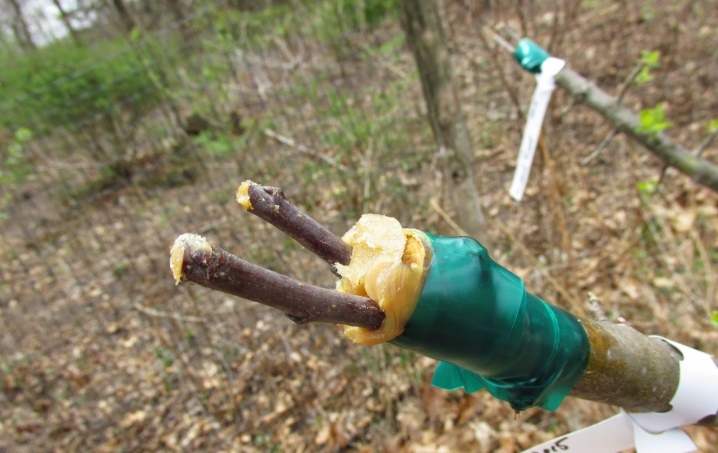













The comment was sent successfully.